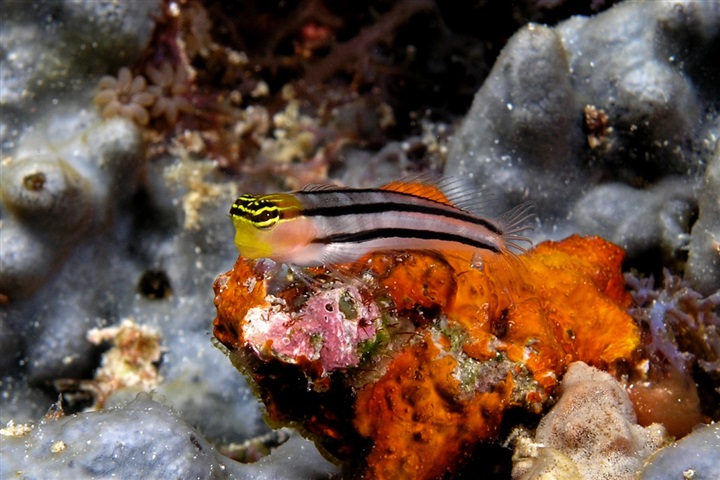Ecsenius bathi

| Latin name | Ecsenius bathi - Springer, 1988 |
|---|---|
| Local name | Bath's comb-tooth |
| Family | Blenniidae - Ecsenius |
| Origin | Australia, Indonesia, Central/West Pacific |
| Max length | 5 cm (2") |
| Minimum volume |
100 l (26 gal) |
|---|---|
| Hardiness |
Hardy |
| Suitable for aquarium |
Suitable for most aquarium |
| Reef safe |
Often reef safe |
| Aggressiveness | Mostly peaceful but might be aggressive towards similar species |
| Recommended |
Macroalgea (Eg. seaweed / nori) Microalgea (Eg. spirulina) Small crustaceans (Krill, mysis, artemia...) Zooplankton (Cyclops, pods...) |
|---|
This species is known to jump out of open aquaria.
This species sometimes nibbles at clams including Tridacna species.
These fish flourish better without other members of the same species in the aquarium.
These fish should be kept in a well run aquarium where they can "graze" algae from rocks and stones.
If there are insufficient algae on the rocks, it is important to feed more frequently and supplement with algae rich food e.g. Spirulina.
This species often has a fun and interesting personality.
This species needs good hiding places, for example, between live rocks.
Even though these fish enjoy a diverse type of frozen foods, it is imperative that its primary food, is algae based, thus ensuring that the fish`s immune system remains healthy.
This can, for example, be plant based fish flakes, Nori seaweed or similar.
Fish in the Ecsenius genus are very popular for fishtanks, normally easy to look after and fitting well in most aquaria.
There are many differences within the Toothcomb Blennies family, some eat algae whilst others eat zooplankton. There are many families of Blennies, this is merely one of them.
What they have in common are their oblong shape and long dorsal fin. Some species have small "legs" used to move around the bottom.
These Blennies do not normally get very big and are therefore a good choice for both small and large aquaria. They are not often very colorful, but many have a fun personality which many aquarists fall for.
The species of the families Aspidontus and Plagiotremus imitate Cleaner Wrasses and can therefore be difficult to identify.
| Aquarium trade | Yes |
|---|---|
| Distribution | Western Central Pacific: Indonesia and Malaysia (Ref. 50537). |
| English common names |
Bath's comb-tooth Bath's coralblenny |
Bob Fenner. Combtooth Blennies of the Genus Ecsenius - Wet Web Media - (English)
Jeff Kurtz. 2007. Combtooth Blennies: Bewitching Bottom Dwellers - Tropical Fish Hobbyist - (English)
Scott W. Michael. Reef Aquarium Fishes: 500+ Essential-to-know Species - TFH Publications / Microcosm Ltd. - (English)
Bob Fenner. The True/Combtooth Blennies, Family Blenniidae - Wet Web Media - (English)
Bob Fenner. Blennioids: Blennies and Blenny-Like Fishes - Wet Web Media - (English)

